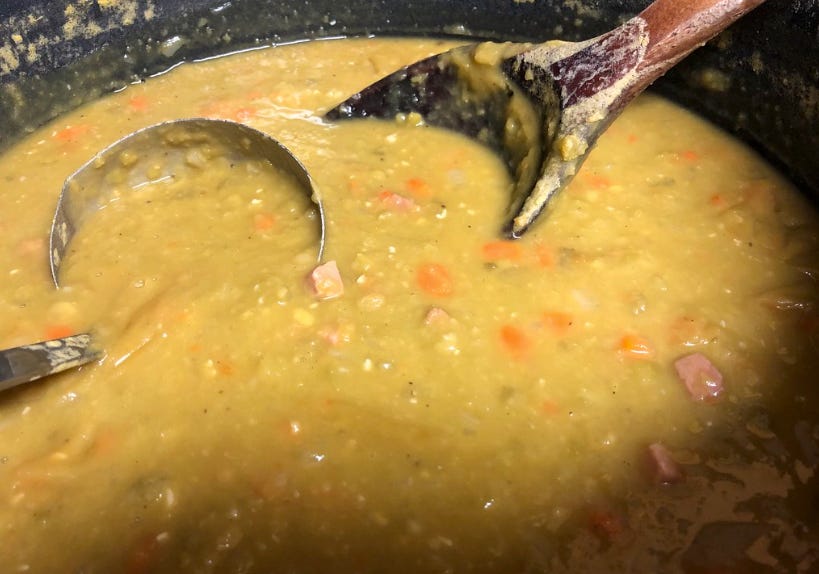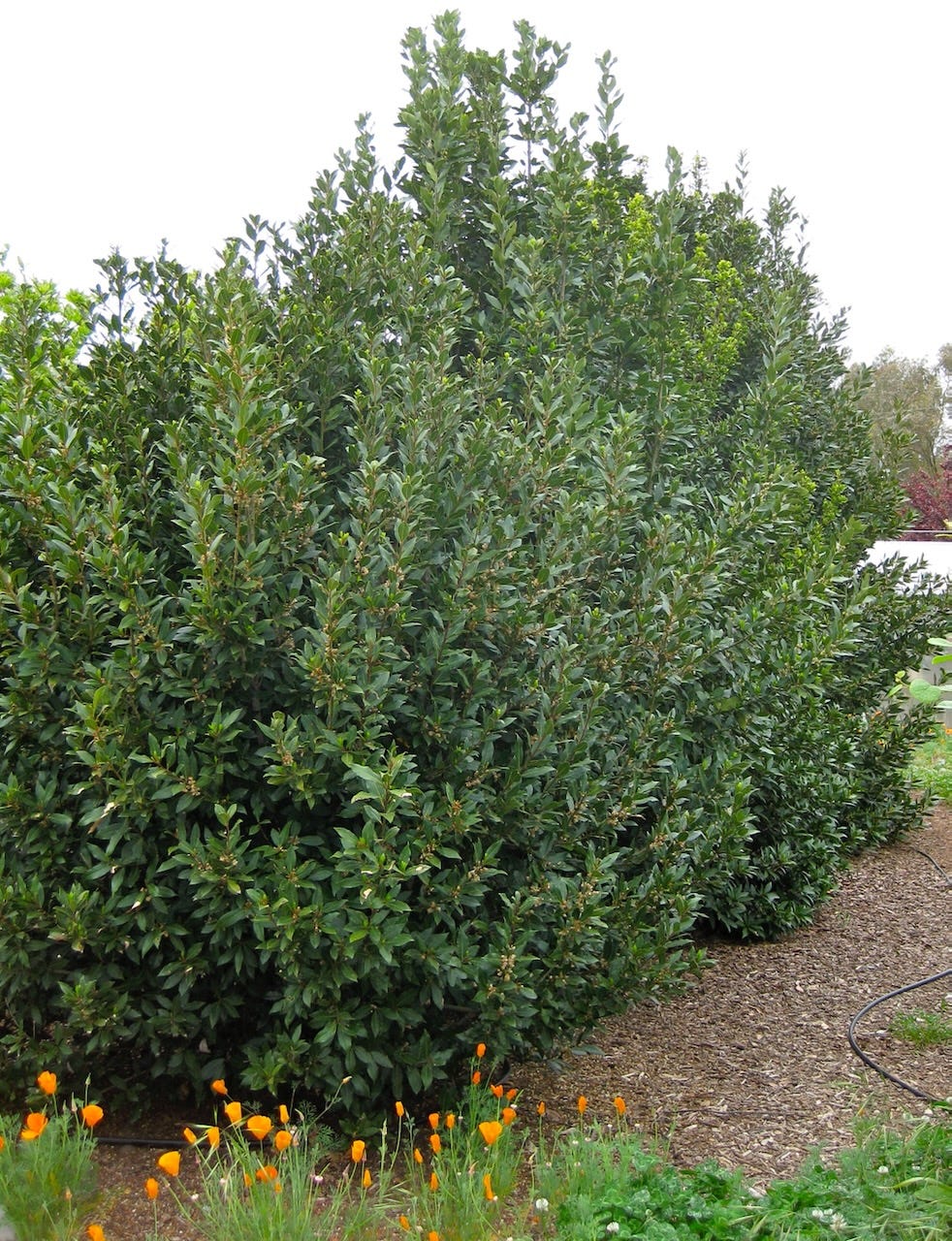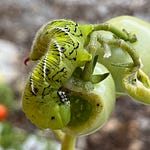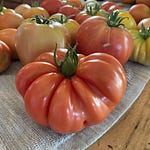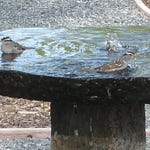Here is Andi MacDonald’s “More Than Basic Split Pea Soup” vegan recipe. It serves 6-8 people. She explains its origins:
“My Aunt Carol lived on the Central Coast of California. When we visited, my father took us to Pea Soup Andersen’s restaurant in Buellton, where we dined on endless bowls of pea soup. Ten-year-old me thought that this was the height of culinary genius. I went back a few years ago and concluded that the soup was okay, bit it needed more oomph. That’s what this version is: basic comfort, but with a bit more to it.
Directions are for an Instant Pot. To make this on the stovetop, follow the basic directions, but cook it for a couple of hours, stirring frequently to prevent scorching.”
Ingredients:
1 lb dried split peas
1 Tbs olive oil
1 medium onion, diced small
2 medium carrots, diced small
2 stalks of celery, diced small
6 cloves of garlic, minced
2 medium russet potatoes, peeled and diced small
1 Tbs fresh thyme leaves (or 1 tsp dried)
1 Tbs fresh oregano, (or 1 tsp dried)
1-2 bay leaves
1/2 tsp black pepper
8 cups vegetable stock (low sodium preferred)
1 Tbs soy sauce
1 Tbs liquid smoke
Salt to taste
Set the Instant Pot to sauté. Cook the onions, carrots, and celery in olive oil until the onions soften. Stir in the garlic and cook for about one minute. Add the thyme, oregano, bay leaves, and pepper. Add the vegetable stock, soy sauce, and liquid smoke. Add the potatoes and the split peas.
Put the lid on the Instant Pot and seal. On manual mode, set the time for 20 minutes. When the timer goes off, let the pot release naturally for 30-40 minutes.
Release the valve, and stir the soup vigorously for a minute or so to break down the split peas. Taste, and add salt if needed.
This soup will thicken as it sits. If made ahead (and refrigerated), you will need to thin it with water or stock before reheating.
For more cooking tips, check out Andy’s Magic Apron on Facebook.
I have questions, I have thoughts:
What is in Wright’s Liquid Smoke? (Answer: not much)
The Bay Laurel
You can grow just about every ingredient in this split pea soup recipe in your home garden. However, one ingredient in the recipe caught my fancy, because it is one of my favorite plants to grow, the bay laurel, also known as Sweet Bay or Grecian Laurel (Laurus nobilis).
If I may quote the American Horticultural Society book, “The Encyclopedia of Garden Plants”:
The Bay Laurel is “an evergreen, broadly conical tree, about 40 feet tall and 30 feet wide. For USDA Zones 8-10. Narrow oval, leathery, glossy, dark green leaves are very aromatic and used in cooking. Small, star-shaped, pale yellow flowers are borne in spring and are followed by globose to ovoid, green, then black fruits.”
The bay tree is frost hardy, but foliage may be scorched by extremely cold weather or strong, cold winds. Needs a sheltered position in sun or semi-shade and fertile, well-drained soil. In tubs, may be grown well as standards, which should be trimmed during the summer. Propagate by semi-ripe cuttings in summer or by seed in autumn.”
My thoughts on this plant: WINNER, WINNER, WINNER! In Northern California, it is easy to care for and not fussy about watering. Prune or don’t prune. It’s up to you. Bay laurel is a great, evergreen privacy screen that isn’t overly messy (because of the weight of the leaves, fallen ones tend to stay nearby the plant). We had a row of these at the old radio ranch in Herald, CA next to a swimming pool, and never had to skim out any bay laurel leaves. And, it was a great privacy screen located 15 feet away from the hot tub. p.s. The official Town Motto for Herald: “Where’s Herald?”.
Because it is a broadleaf evergreen tree, the small birds - finches and wrens especially - love it for perching and nesting. The happy bird chatter from our row of bay laurels in the early evening was a delight. They were probably describing their day to others, hunting for garden pests. Did they pick off leaves of desirable garden plants? Yes. So, you plant enough for everyone to enjoy! Birds are always welcome in my garden.
If you listened to Episode 254 of the Garden Basics podcast (the Feb. 24, 2023 edition), you heard aromatherapist Amy Anthony rave about the bay laurel, as well. The scent, she says, can help you build courage. Sounds like a plant every cold-call salesperson should own.
The bay laurel is slow to grow, especially from cuttings. But once it takes off, it shoots up to 20 feet or more in less than ten years. (“Ten years?!? I don’t want to wait no ten years!”). Trust me, it’s worth the wait.
Thank you for listening to the Garden Basics with Farmer Fred podcast! It’s available wherever you get your podcasts. Please share it with your garden friends.
As an Amazon Associate, I earn from qualifying purchases from some of the underlined links in the newsletter. This is how I am trying to keep this a free newsletter. And as long as you buy whatever you want from Amazon using any of those links to get into the Amazon site, I get a few pennies. Thank you.
Thanks for Subscribing and Spreading the Word About the Beyond the Basics: The Garden Basics with Farmer Fred newsletter, I appreciate your support.
Fred Hoffman is also a University of California Cooperative Extension Master Gardener in Sacramento County.



